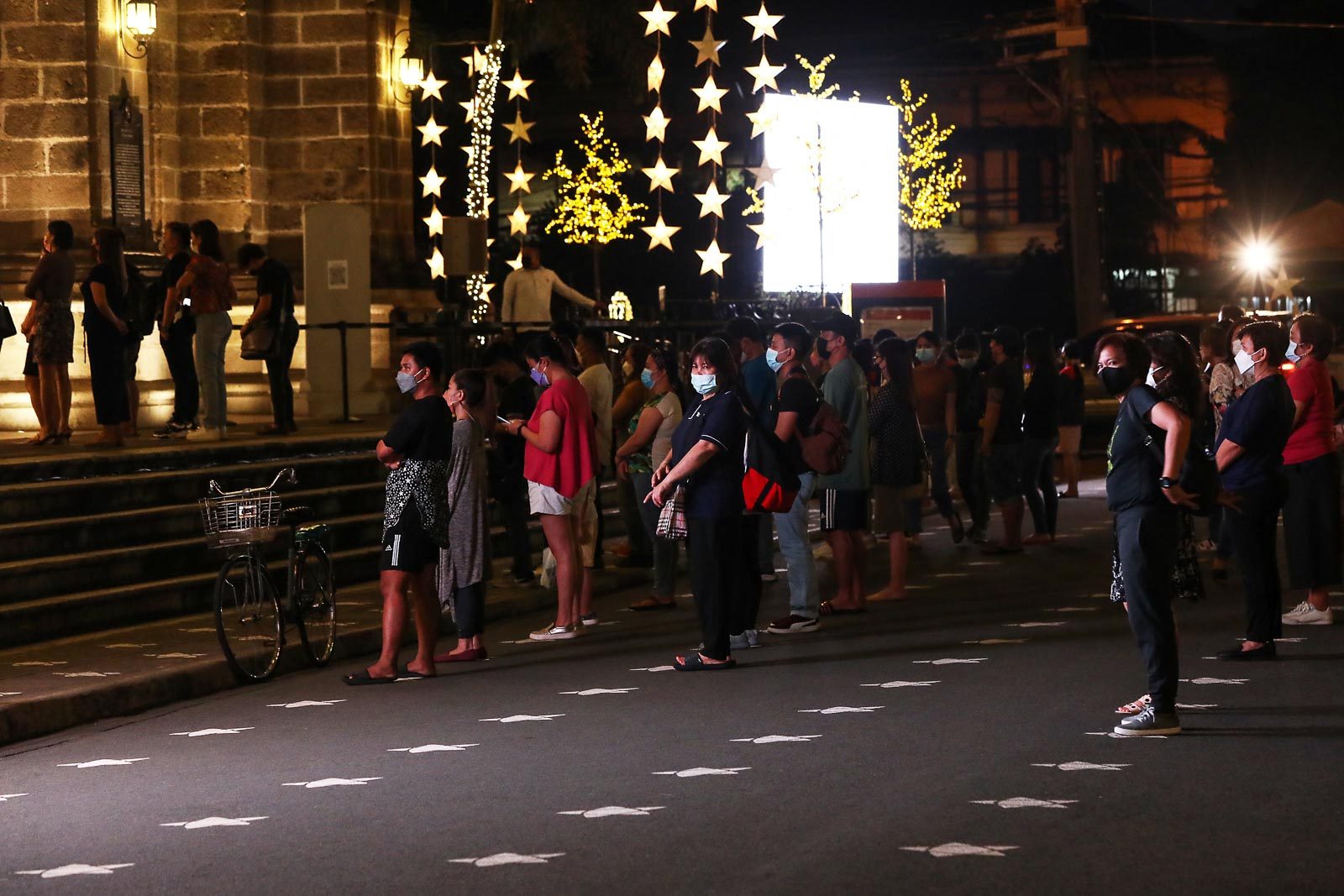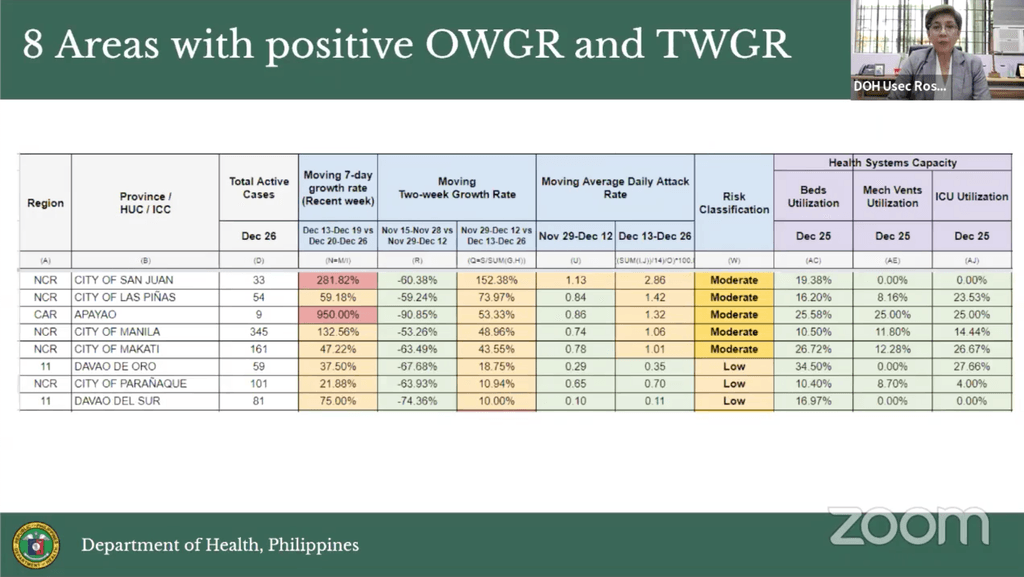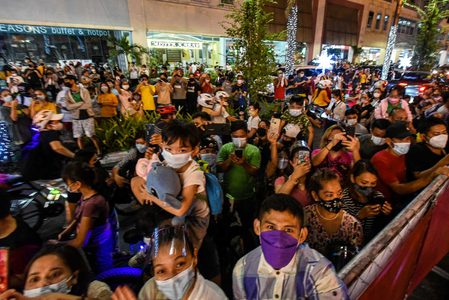SUMMARY
This is AI generated summarization, which may have errors. For context, always refer to the full article.

MANILA, Philippines – There has been a slight increase in the number of COVID-19 cases Metro Manila registering in the recent week, with 14 out of 17 cities in the capital region showing increases in both infections and positivity rates, health officials said.
Health Undersecretary Maria Rosario Vergeire told reporters in a press briefing on Monday, December 27, that cases in the capital region grew by some 49% in the last week, although it remained at “minimal risk” of COVID-19 for now.
“In the National Capital Region (NCR), the daily cases in the recent week showed an increase of 38 [cases] or 49% cases from the previous week, now averaging 115 cases per day,” Vergeire said.
Data gathered as of Sunday, December 26, also showed that, of the eight areas the Department of Health (DOH) was flagging for both positive one-week and two-week growth rates, five were from Metro Manila. They included the following:
- City of San Juan
- City of Las Piñas
- City of Manila
- City of Makati
- City of Paranaque
The following provinces were also flagged: Apayao, Davao de Oro, and Davao del Sur.

In addition, of 31 other highly urbanized cities and independent component cities showing positive one-week growth rates in cases, but not yet two weeks, eight or 26% were in the National Capital Region.
These areas currently had less than 100 active cases, Vergeire said, but “we (DOH) are flagging these areas so that these increases can be immediately controlled.”
What to watch
A key metric used by the government to determine the spread of COVID-19 infections – the the reproduction number – has also doubled in Metro Manila, but an experts group monitoring the pandemic says the figure is not alarming enough to warrant tighter restrictions or lockdowns.
Guido David, an analyst with Octa Research, said on Monday that the reproduction number in Metro Manila doubled in a week. From 0.44 on the week of December 20, it shot to 0.85 this week, or the week after Christmas. In early December, the reproduction number was only 0.33, the lowest reproduction rate seen in Metro Manila.
“It practically doubled compared to last week,” said David on the virtual Laging Handa press briefing.
“We have to put it in context that the reproduction number is still less than one, so it’s not yet a big uptick in cases. The trend is not a solid trend upwards,” he added.
The reproduction number is the number of people a COVID-19-infected person is likely to infect. A reproduction number of two means a person is likely to infect two people. That’s why the ideal reproduction number is less than one because it means an infected person is not likely to transmit the virus to another. Along with average daily attack rate (ADAR) and test positivity rate, the reproduction number is one of the metrics the government and experts regularly monitor to spot trends in transmissions in a given area.
Based on DOH data, the ADAR in NCR was .69 per 100,000. Indicators also showed that, while the positivity rate across all regions remained to be less than 5%, an increase in positivity rate was observed in Metro Manila and Calabarzon.
Specifically, data showed that the positivity rate in NCR climbed from .70% from December 12 to 18, to 1.5% from December 19 to 25. In Calabarzon, the positivity rate increased from .6% to .9% during the same period.
The ADAR is the number of new cases in a city or province over a two-week period, divided by the population of the city or province. An ADAR that is less than one means that area is at low risk for COVID-19. Positivity rate is how many test samples against the total turn out positive.
While these indicators point to an uptick in cases, David said we were yet to see the full picture of these December transmissions because of reduced testing output over the holidays and due to Typhoon Odette (international name Rai). Some testing laboratories were closed over the Christmas break while many could not function because of the storm’s impact on their personnel or facilities.
Because of this, David said there was not enough data to warrant a new wave of restrictions or lockdowns.
“There’s no need to increase restrictions at this time because it could just be a holiday uptick, which means, after the holidays, the number of cases could go down. Right now, we can’t make premature interventions because the picture is not yet complete,” said David.
But he said the increase in reproduction number is a “good reminder” to the public to observe protocols, like consistent mask wearing, social distancing, and ensuring good ventilation when going out or meeting other people. David cited anecdotal evidence of “complacency” among Filipinos, where some would test positive after attending Christmas parties or reunions.
Can’t say Omicron is a factor yet
The slight uptick in reproduction number comes as the government announced the fourth case of the Omicron variant in the Philippines. Like the first three, the infected person came from overseas travel. This means no local transmission of the variant has been detected in the country.
But, as it prepares for the eventual entry of the variant, Vergeire said the DOH was looking to minimize the impact of Omicron in the country by further ramping up vaccinations among the elderly and high-risk population, who were observed to have the highest likelihood of hospitalization and death.
Aside from this, Vergeire urged local governments to step up immediate case detection, isolation, and contact tracing to help slow transmission.
David also said it was possible that the increase in reproduction number was only due to increased activity during the Christmas holiday.
“If we compare it to the 2020 holiday season, December, we also had a holiday uptick so we can’t say it’s Omicron-driven because we also saw it last year,” he said.
Octa Research observed the rise in cases last year before December. This year, the increase was seen during the holiday season itself.
There are currently over 9,300 active COVID-19 cases in the Philippines. Metro Manila has been classified to have “minimal risk” for COVID-19 since early December, prompting an easing of restrictions that have allowed residents to hit the cinemas, hold some limited social gatherings, and let their kids step into malls for the first time in nearly two years. – Rappler.com
Add a comment
How does this make you feel?


There are no comments yet. Add your comment to start the conversation.